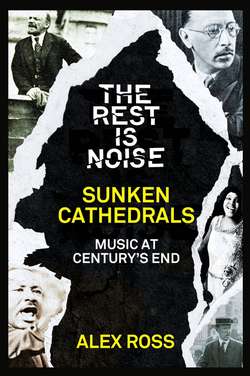Читать книгу The Rest Is Noise Series: Sunken Cathedrals: Music at Century’s End - Alex Ross - Страница 6
15 SUNKEN CATHEDRALS Music at Century’s End
ОглавлениеAs Highway 1, the California coastal highway, goes north of San Francisco, it holds the eyes like a work of art. The landscape might have been devised by a trickster creator who delights in grand gestures and abrupt transitions. Rolling meadows end in cliffs; redwood trees rise above slender patches of beach. Towers of rock rest on the surface of the ocean like the ghosts of clipper ships. A lost cow sits on the shoulder, looking out to sea. Side roads head up the inland hills at odd angles, tempting the aimless driver to follow them to the end. One especially beguiling detour, the Meyers Grade Road, departs from Highway 1 shortly after the town of Jenner. The grade is 18 percent, and the steepness of the ascent causes dizzying distortions of perspective. The Pacific Ocean rises in the rearview mirror like a blue hill across a hidden valley.
Not far from here is Brushy Ridge, the forest home of the composer John Adams. One way to describe his work is to say that it sounds like Highway 1. It is a cut-up paradise, a stream of familiar sounds arranged in unfamiliar ways. A glitzy Hollywood fanfare gives way to a trancelike sequence of shifting beats; billowing clouds of Wagnerian harmony are dispersed by a quartet of saxophones. It is present-tense American romanticism, honoring the ghosts of Mahler and Sibelius, plugging into minimalist processes, swiping sounds from jazz and rock, browsing the files of postwar innovation. Sundry sounds are broken down and filtered through an instantly recognizable personal voice, sometimes exuberant and sometimes melancholy, sometimes hip and sometimes noble, winding its way through a fragmentary culture.
Brushy Ridge is at the far end of the Meyers Grade Road, and the last part of the drive is a matter of guesswork. The Adams house, at the top of a rocky hill, is a comfortable, earthy, rural-hippie kind of place; not too long ago, it served as the headquarters for a pot farm. Walking in, you might find the composer asleep on the couch with the collected poems of Allen Ginsberg lying open in front of him. He has a youthful face, framed by a neat, silvery beard. His eyes are sometimes bright with curiosity, sometimes clouded with a slight sadness. There is an appealing innocence about him, but it is an innocence sharpened by confidence. He speaks in mild, unhurried tones, halting to look for the right words. On occasion, he breaks into an unexpectedly aggressive cackle, underscoring it with a clap of his hands and a merry roll of his eyes.
Adams makes his way across a ravine to a modern ware house. “My composing shed,” he calls it. There is a tradition of composers working in the woods; Sibelius’s Ainola is surrounded by a stand of forest, and Mahler wrote most of his symphonies in rustic one-room studios constructed to his specifications. Adams can claim the largest composing hut in history. He raises the overhead door and walks through the space, part of which is rented out to a woodcutter neighbor. There is a sharp smell of freshly cut redwood. He goes into a smaller room, where sheets of music paper are scattered around an electronic keyboard and a computer terminal.
It is the year 2000, and Adams is writing an oratorio called El Niño—a latter-day, Spanish-inflected retelling of the Christmas story. He fiddles with the keyboard, commanding the computer to play an aria for mezzo-soprano and orchestra titled “Pues mi Dios ha nacido a penar,” or “Because My Lord Was Born to Suffer.” In meekly peeping tones, the computer sings a sinuous, long-breathed melody, twisting and turning over lullaby chords. After about fifty bars the music trails off into a single line. The composer stares at the floor, cupping his chin in his hand. Then he goes back to work, chipping away at the silence of everything that remains to be composed.
